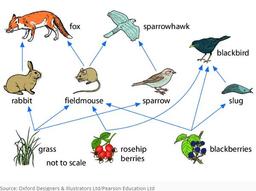
SCI 5B Unit 4 Test Review (Food Webs and Cycles)
Quiz by Jessica Smith
Feel free to use or edit a copy
includes Teacher and Student dashboards
Measures 4 skills from
- edit the questions
- save a copy for later
- start a class game
- automatically assign follow-up activities based on students’ scores
- assign as homework
- share a link with colleagues
- print as a bubble sheet
- Q1
If an ecosystem didn't have ____________, the consumers and decomposers wouldn't have food.
rocks
abiotic
producers
tertiary consumers
30sSCI.5.12B - Q2
Herbivores eat producers.
truefalseTrue or False30sSCI.5.12A - Q3
Omnivores eat _________ and other consumers.
Users enter free textType an Answer30sSCI.5.12A - Q4
Carnivores eat only __________.
consumers
producers
plants
30sSCI.5.12A - Q5
What do organisms depend on to recycle waste and dead material?
decomposers
producers
consumers
30sSCI.5.12A - Q6
A food ______ shows one path energy flows in an ecosystem.
chain
web
30sSCI.5.12A - Q7
A food ______ in composed of multiple food chains that are in an ecosystem and shows how the food chains are interconnected.
Users enter free textType an Answer30sSCI.5.12A - Q8
According to the unit, the ___________ cycle is a huge recycling system for the entire planet. It involves: evaporation, transpiration, condensation, precipitation, runoff, and collection.
carbon
nitrogren
water
30sSCI.5.10A - Q9
The movement of carbon dissolved in ocean water into the rocks is an example of the carbon cycle occurring slowly.
truefalseTrue or False30sSCI.5.10A - Q10
In the nitrogen fixation process, soil bacteria convert nitrogen into ammonia, nitrites, and then nitrates. Nitrates are then absorbed by producers.
truefalseTrue or False30s - Q11
Which food chain below is in the correct order?
grass >>> snake >>> hawk >>> mouse
snake >>> mouse >>> grass >>> hawk
grass >>> mouse >>> snake >>> hawk
30sSCI.5.12A - Q12
Look at the image. Which animal would be considered a primary consumer?
beetle
mouse
owl
plant
30sSCI.5.12A - Q13
Look at the image. Which would be considered the producer?
mouse
beetle
owl
plant
30sSCI.5.12A - Q14
An _____________ species is a species that is brought into an ecosystem that is not its native ecosystem that disrupts the balance of the ecosystem. Example: Pythons were brought into Florida. These snakes grow to be sometimes 20 feet long and are eating the mammals and birds. They have seem a major decline in the animal population because of this massive snake problem.
intersecting
official
invasive
adverse
30sSCI.5.12C - Q15
Invasive species can be introduced by human into an ecosystem through inventions like care, boats, and planes.
truefalseTrue or False30s